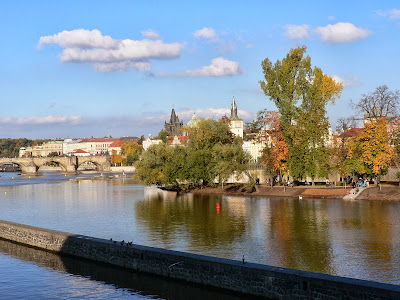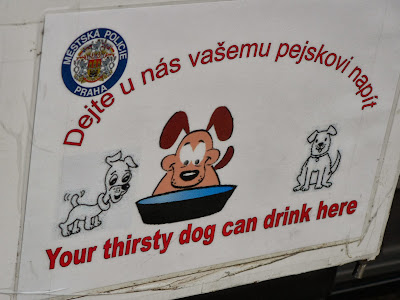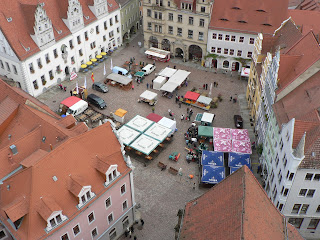Prague, Czech Republic
(Ref the previous post regarding problems getting the blog online. I tried an alternative approach which seems to be working. Cross your fingers, and stay tuned.)
Another great breakfast buffet at our
hotel in the woods in Moritzburg. (Cheeses, meats, eggs, cereals,
four kinds of fish, breads and rolls, pastries, yogurt, fruits and
vegetables like tomatoes and cucumbers.) Then we made a brief visit
to the castle on the island. Spectacular from a distance, and
spectacular close up.
There was quite a display of how they
had analyzed and recreated the technique of weaving large wall
hangings from feathers, and then we got to see the real thing in the
king’s massive bedroom. The hangings there were indeed original but
had undergone quite a bit of restoration. No photographs were
allowed due to the sensitive nature of the material.
Then to another exhibit that
concentrated on illustrating the major scale of operating an
establishment of this magnitude. Many detailed logs of kitchen
activities, compiled with German fastidiousness, had helped the
historians piece together what comprised a typical state dinner, and
how many people it took to successfully make it happen.
Then back in the car for the drive to
Prague. Dresden, the state capital of Saxony, was directly on the route and we had hoped to stop and see a bit of it, but time just wouldn’t permit. We did manage to drive right through the area along the river where the impressive large buildings are located—it was mobbed with tourists and with people getting out of church—and it was easy to decide that the city would have required a visit of a few days, with a good guidebook. Next time?
We intentionally took the back roads
from there and were well rewarded with absolutely gorgeous views, both in far
southern Germany and after we crossed the border into the Czech
Republic. We would go so far as to say that the fall foliage, now
showing a lot of red, was as good as one could find anywhere in New
England, and the big vistas easily rivaled those seen in Vermont.
(We tend toward smaller vistas in New Hampshire.)
The moment we crossed the border we
encountered a mass of commerce. Many, many roadside stands all
offering the exact same line of products: baskets, birdhouses, bulk packs of
large bottles of soft drinks, and hubcaps! There must be tax or
other such differences that cause this to all happen on the Czech
side of the line. We resisted the temptation. We learned later that
these establishments are all run by Vietnamese people. It’s a small
world.
The Czech Republic was another check mark on Sue Anne and Bruce’s visited countries
list along with Poland, as both places were out of bounds during most
of our previous European experiences.
Easy trip into Prague, just a couple of
times around the block to find a free, longterm parking spot, and we
were at the Hotel Julian, as recommended by Rick Steves. Aimée
and Steve had stayed there before, and it certainly lived up to
theirs and Rick’s recommendation.
The main
part of Prague is divided into a few distinct areas. One is the Old
Town, which is really old. Others are simply pretty darn old. All
have charm. We were staying across the Vlatava River from the Old
Town. Vlatava is AKA Moldau, the name used in the music by Bedřich Smetana which you certainly would have heard if you had ever listened to
Renée Chaney on WGMS in Washington. Here’s a link to a Youtube video
of Smetana’s work, performed by the City of Prague Philharmonic
Orchestra and nicely illustrated with pictures of the city.
After getting settled in the hotel, we started our late afternoon trek with
a drink and a snack at a riverside establishment. We were right
along the canal that led to one of the locks on the river, and we
watched a number of river cruise boats lining up to await the lock.
Then it was off to the Charles Bridge, which is totally given over to
artists, souvenir sellers, and other such vendors, and absolutely
crammed with pedestrians. Crammed.
We walked a bit farther into the
square, studied in awe the world’s oldest working
astronomical clock (pre-Columbus), and then settled in for a great
dinner at a restaurant that was on a quiet side street. Then we
walked along the river with great views of the illuminated castles on
the hills, the churches, and the many bridges, and then back to the hotel
to rest up for the adventures ahead.
Approach to the castle from the town of Moritzburg
View out the back door
The lake continues behind the island.
Autumn roadside view in southern Germany
Another view from the same location
Autumn views continue down into the Czech Republic.
View from up there must be pretty nice.
Rooftop deck at Hotel Julian in Prague
Vlatava (Moldau) River in Prague, with lock canal in foreground
Nope, it’s not somebody driving up the river. It’s a cleverly designed pedal boat.
Bridge over the Vlatava. There were streetcars everywhere.
View from the Charles Bridge, looking upriver toward the falls
Typical scene on the Charles Bridge. Sellers and crowds.
And lots of statues
This statue is occupied
Production line! Woman preparing cylindrical rolls of sweet crispy pastry. We had some with our hot wine.
Approach to the square, with astronomical clock on the left
View in the square
There was a police van in the square, open to offer assistance if required. It featured a large sign warning of the danger of dealing with illegal currency exchangers who apparently often work in the area. (Czech Republic isn’t in the Euro, so currency exchange is still a big thing here.)
The police van also featured this sign.
These fellows were also there, ready to take you on a carriage ride.
Bruce’s dinner at a nice restaurant just off of the square. It could be called Rouladen Cordon Bleu.
The veggies were nice and crisp.
It was dark when we left the restaurant. Here are some of the views we encountered on the way back to the hotel.
Fireworks were an unexpected treat. I didn’t even see them till I inspected the picture.





























































